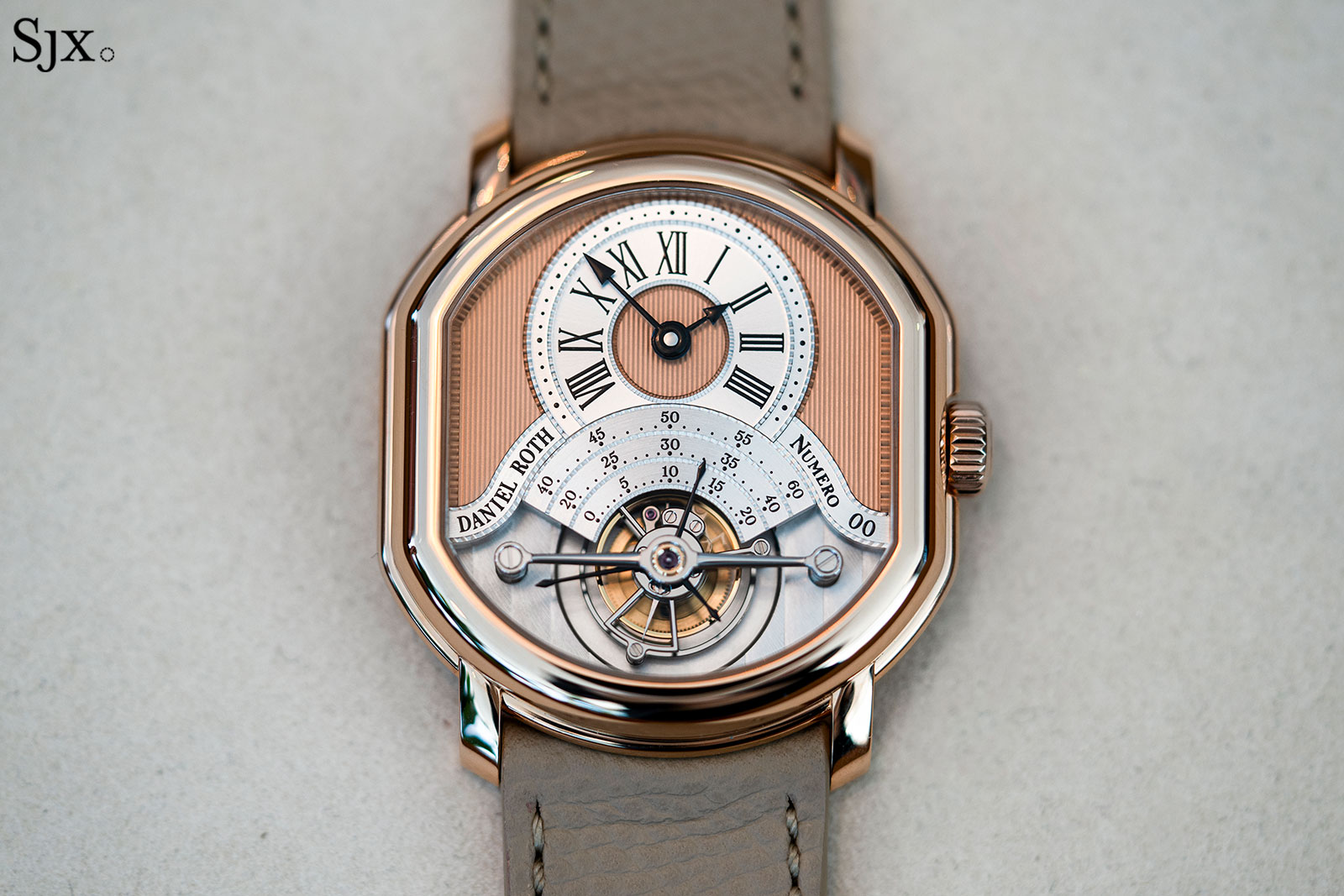Hands On: Daniel Roth Tourbillon Rose Gold
An open back to showcase the calibre.
Following the revival of Daniel Roth with the launch of the limited edition Tourbillon Souscription last year, the brand is now building its catalogue with the Tourbillon Rose Gold, which will be a regular production model.
The Tourbillon Rose Gold is a variation of the original with tweaks to the decoration and material, but most significantly, the new tourbillon is fitted with a display back that shows off the DR001 movement.
Initial thoughts
It was expected that Daniel Roth would follow up with a regular production tourbillon, so the Tourbillon Rose Gold is not surprising. Like the Souscription, it has an obviously high quality of make in construction, finishing, and details.
Both the dial and case are 5N rose gold so it is strikingly pink, giving it a stronger presence than the Souscription, which in comparison is low key.
It was a shame that the DR001 movement was hidden in the Tourbillon Souscription because the calibre is worth admiring. The movement is high quality in both design and finishing, boasting many details that enthusiasts now regard as key elements of haute horlogerie.
The quality of finishing is impressive. In fact, the movement decoration is as good as some small-scale independent brands, reflecting the attention to detail that has characterised the resurrected Daniel Roth brand.
Admittedly, such fine finishing isn’t as rare as it once was, since it is now sought after by enthusiasts and specialist subcontractors have sprung up to cater to that demand. But the DR001 is notable for coming from what is essentially a big brand; although Daniel Roth makes a few dozen watches a year at most, it is backed by Louis Vuitton and LFT. This bodes well for upcoming Daniel Roth creations, which might be less complicated and more accessible.
The Tourbillon Rose Gold costs CHF155,000, slightly more than the Souscription. Though it’s a big number, the price is fair relative to the wider market, where even startup independents with iffy longevity charge a similar number for a tourbillon.
Or rose
The Tourbillon Rose Gold retains exactly the same form as the Souscription, while the case metal is now 18k rose gold instead of yellow. This also means it’s almost exactly the same as the 1990s originals, save for a few tweaks to the design.
According to its designer, Matthieu Hegi, the case was reworked to be more harmonious, so the angular lugs of the original were replaced with curved lugs with rounded ends. The ratio of bezel-to-back thickness was also improved, so the case has a more balanced profile.
As was the case with the Souscription, the dial quality is noticeably superior to that on the originals. The linear guilloche is finer, as are the fluted borders of the applied chapter rings.
The dials are made by Comblemine, the arm of Voutilainen that specialises in dials and cases. Although Comblemine supplies guilloche dials to a great number of small brands, they vary in complexity and sophistication. The Daniel Roth dials are amongst its better work.
The feature has the markings in black, along with black-coated hands
The applied chapter rings are solid silver while the dial is rose gold
The best bit of the new tourbillon is the back, which has a sapphire window. In contrast, the Tourbillon Souscription had a solid back that stayed true to the 1990s original. Excepting the engraved examples, the originals did not warrant a display back because the view on the rear was uninspiring.
The new tourbillon next to the Souscription with its solid back (left)
Here, however, the DR001 looks good. The same movement was found in the Souscription, but concealed. It’s manual wind with a long power reserve of 80 hours.
Developed by La Fabrique du Temps (LFT), the movement-making arm of Louis Vuitton’s watch division, the DR001 has a classical appearance. LFT was also responsible for other high-end tourbillon movements in the past, so there are shared genetics between the DR001 and LFT’s past creations.
The LFT emblem on the base plate
The movement has a traditional layout with the barrel at 12 o’clock and the tourbillon at six, but is still recognisable as a modern movement that was designed to show off finishing.
Most of the moving parts are held in place by two large bridges that are striped on the top and bevelled on the edges, with additional fine detailing on the smaller parts. The largest jewel, for instance, is secured by a wide, polished gold chaton.
The decoration is impressively high quality and equivalent to the artisanal finishing found in some examples of independent watchmaking.
A black polished steel cock
Key facts and price
Daniel Roth Tourbillon Rose Gold
Ref.
Diameter: 38.6 mm by 35.5 mm
Height: 9.2 mm
Material: 18k rose gold 5N
Crystal: Sapphire
Water resistance: 30 m
Movement: DR001
Features: Hours, minutes, seconds, and a one-minute tourbillon
Frequency: 21,600 beats per hour (3 Hz)
Winding: Manual winding
Power reserve: 80 hours
Strap: Calfskin strap with pin buckle
Limited edition: No
Availability: At Daniel Roth at retailers
Price: CHF155,000 excluding taxes
For more, visit Daniel-roth.ch.
Back to top.